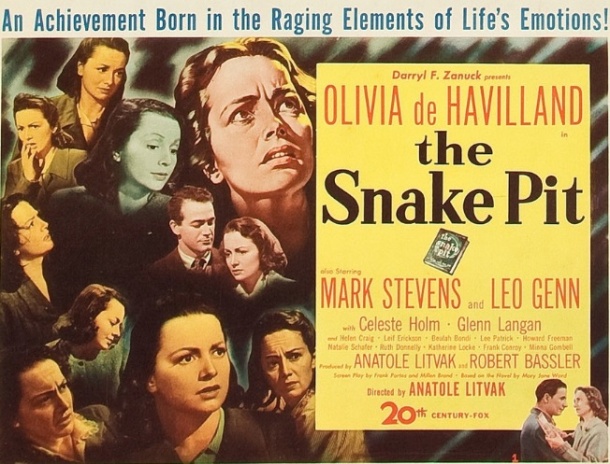The Snake Pit (1948)
Directed by Anatole Litvak
20th Century-Fox
The Snake Pit wasn’t the first film about mental illness, but it’s one of the most significant.
German Expressionist films like The Cabinet of Dr. Caligari (1920) and M (1931) are powerful films about mental illness, but they’re more horror films than they are dramas, and they don’t explore the day-to-day reality of life in mental asylums. Films like Maniac (1934) and Dead of Night (1945) are at least partially about “crazy people,” but again, mental illness is used as a horror trope, not a sad and difficult fact of life.
The Seventh Veil (1945) and Spellbound (1945) both dealt with psychoanalysis, but they were designed to appeal to a public newly interested in Freudian theory, and didn’t touch on the facts of life in state mental institutions.
In fact, the only movie I can remember seeing before The Snake Pit that really dealt with life inside a mental institution was Mark Robson’s Bedlam (1946), but the fact that it was both a horror film and a period piece gave audiences a comfortable sense of remove.
The Snake Pit changed all that. It was based on the novel by Mary Jane Ward, who spent eight and a half months in a mental hospital. She was institutionalized for schizophrenia, which was possibly misdiagnosed. The Snake Pit was rejected by several publishers. When it was eventually released in a small print run in 1946 it became an unexpected bestseller and was reprinted many times. It was a novel, not a memoir, but it contained autobiographical elements and most of the characters were based on people Ward had known in Rockland State Hospital.
The film version of the the novel stars bona fide superstar Olivia de Havilland in an unglamorous, makeup-free performance as Virginia Stuart Cunningham. The film drops us into Virginia’s schizophrenic experience in media res. She’s sitting on a park bench, looking up at the sun shining through the branches of a tree. On the surface, it’s idyllic, but we soon notice that her clothes are threadbare and her nylons have a run in them. Her voiceover conveys how confused she is about where she is and what she’s doing there.
Her fellow inmate, Grace (Celeste Holm), is more aware of what’s going on and guides Virginia into the group of women when the noontime break is over. They are shuttled inside by the nurses, and Virginia’s surroundings resemble a prison. There are even iron bars.
This is a major theme in the film. Virginia is locked in a prison of her mind’s own making — her mental illness. But she is also locked in a very real prison — a mental institution where electroshock treatments, cruel staff, and harsh conditions are the norm.
The one bright spot for Virginia inside the institution is Dr. Mark van Kensdelaerik (Leo Genn), who is only ever referred to as “Dr. Kik,” because Americans find his surname too hard to pronounce. Dr. Kik has a picture of Freud hanging in his office, and believes psychoanalysis is the key to Virginia’s recovery.
I had some uncharitable things to say about Leo Genn in my review of Mourning Becomes Electra (1947), but that was more about his miscasting than anything else. He’s perfectly cast in The Snake Pit, and his performance is wonderful. His Freudian explanation of Virginia’s condition is a bit too neat, but audiences in the 1940s liked their stories with every T crossed and every I dotted.
The other man in Virginia’s life who cares for her is her husband, Robert Cunningham (Mark Stevens), but there’s very little he can do for her. Through a series of heartbreaking flashbacks, we see her grow increasingly fearful of him and confused about reality.
The Snake Pit was directed by Anatole Litvak, a Ukrainian director who became an American citizen in 1940. Litvak’s previous couple of films, The Long Night (1947) and Sorry, Wrong Number (1948), were both beautifully crafted, but they weren’t as powerful or as resonant as The Snake Pit. The scene in which the title of the film is realized visually is one of the most haunting I’ve ever seen.
Litvak’s direction is wonderful, but none of it would work without Olivia de Havilland’s phenomenal performance. She was nominated for an Academy Award for best actress, but she lost out to Jane Wyman for her role in Johnny Belinda (1948). The Snake Pit actually had an extremely high portion of its budget devoted to hiring seasoned and professional actors, since Litvak wanted even the small roles in the film to be convincing. It paid off.
In addition to de Havilland’s nomination, The Snake Pit was nominated for Academy Awards for best picture, best director, best screenplay, best score, and best sound recording, which is the only Oscar that it actually won.


